Nutria (Myocastor coypus (Molina, 1782))
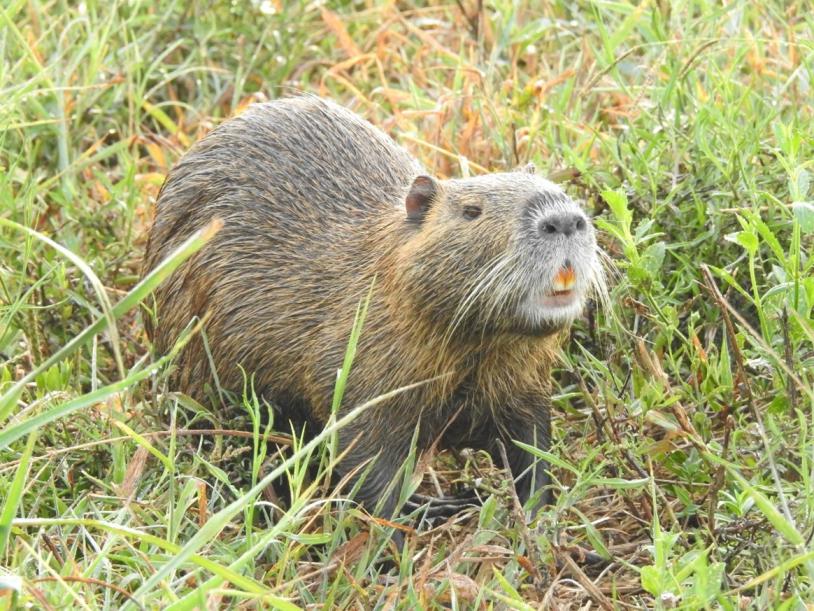
Nutria (Myocastor coypus)
Observation © Joseph Aubert, 2023. iNaturalist.org
French common name: Ragondin
Other names used: Coypu, nutria rat, river-rat, swamp rat, swamp beaver, South American beaver
Order: Rodentia
Suborder: Hystricomorpha
Family: Myocastoridae
Did you know? Nutria has been listed as being among the 100 worst invasive species in the world by the International Union for Conservation of Nature (IUCN).
Introduction
The nutria (or Coypu) is a large, invasive, semi-aquatic rodent that resembles a beaver or muskrat and originates from South America. They typically inhabit areas adjacent to bodies of water but can adapt to a variety of habitats. They are most active from dawn until dusk but can be seen at any time of the day. Female nutria are highly reproductive, capable of giving birth multiple times in a single year. Beyond their native range, there are no natural forms of population control, allowing nutria populations to establish and grow rapidly. They are voracious herbivores, known for clearing areas of their vegetation before migrating. Coupled with their proficiency in traveling both on land and in water, nutria pose a significant threat to the environment, particularly wetlands. They serve as vectors for a number of pathogens and parasites that are harmful to humans and livestock.

Nutria measure approximately two feet in length and weigh between 15-20 pounds, with males being slightly larger than females. Upon first impression, they closely resemble and are often mistaken for beaver (Castor canadensis) or muskrat (Ondatra zibethicus) (USDA, 2020). Nutria, however, are smaller than beaver but larger than muskrat. They have a large head, dark-brown fur, and solid body that often appears hump-backed when on land (USDA, 2020). Their eyes, ears, and nostrils are located higher up on their heads allowing them to remain above the waterline while swimming. The females’ four mammary glands, situated on either side of their body, supposedly facilitate a similar function, allowing their young’s noses to remain above the water’s surface while they feed. Their hind feet are partially webbed, making them highly effective swimmers.

Nutria have relatively large front teeth that are typically yellow or orange in colour. They have long white whiskers that protrude from both sides of their nose and are noticeable from far away. Their tails are large and rat-like in appearance, measuring up to 45 cm (17.7 inches) (The Editors of Encyclopedia Britannica, 2023) and containing thin bristly hairs on the surface (USDA, 2020). Comparing the nutria tail to the flattened, broad tails of beavers and the thinly flattened tails of muskrats effectively distinguishes them from one another.
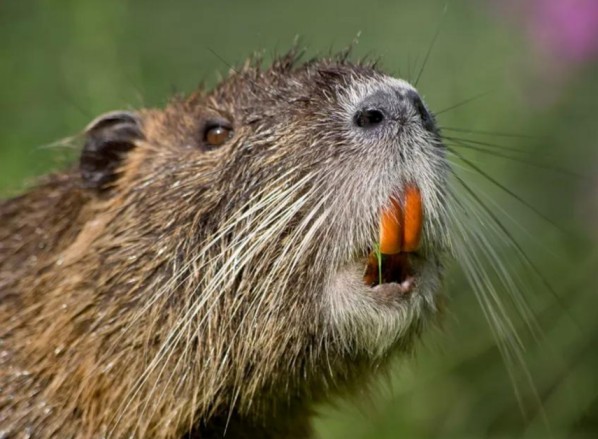
Nutria are often characterized as being crepuscular and nocturnal, being most active around midnight. They are highly reproductive, with females reaching sexual maturity between three and nine months of age (Louisiana Department of Wildlife and Fisheries, 2023). Conversely, males achieve sexual maturity between four and nine months of age. They do not adhere to specific breeding seasons, reproducing whenever they are prepared to have a litter. Females typically produce 4-5 kits per litter, but the number of young born can range from 1 to 13. They are capable, however, of producing litters up to 3-4 times in a single year (Jojola et al., 2005) and can breed again within a day of giving birth (Louisiana Department of Wildlife and Fisheries, 2023). Gestation periods vary, ranging anywhere from 127 to 139 days (University of Wisconsin-Stevens Point, 2023). The young are capable of swimming and eating vegetation after only one day from birth (Chesapeake Bay Program, 2023). The kits are precocial, requiring less care from their mothers and are weaned in less than two months. The nutria’s average lifespan is 6.5 years (Louisiana Sea Grant, n.d.) but have been observed living up to 12 years in captivity. Particularly harsh winters may contribute to decreases in reproductive ability and adult survival.
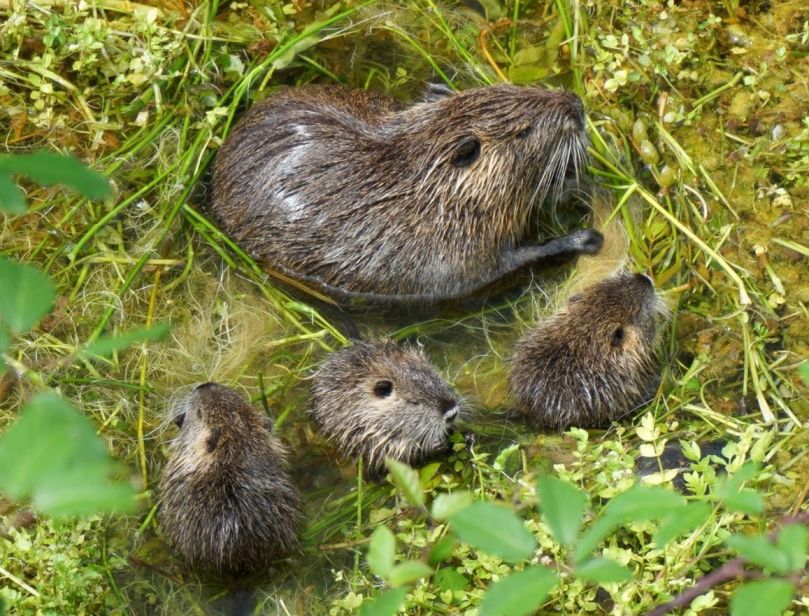
Nutria are highly adaptable to a wide variety of environments but typically inhabit areas near permanent bodies of water. This includes rivers, slow-flowing streams, lakes, ponds, swamps, marshes, and other types of wetlands. While they are frequently seen in freshwater environments, nutria also reside in regions with brackish coastal waters.
Within the United States, the largest nutria concentrations occur in marshes along the Gulf Coast states where they have access to an abundance of wetland vegetation with submerged roots (United States Department of Agriculture, 2020). Using their powerful feet and sharp teeth for digging, they excavate down into the root mat of marshes. Here, they feed on the tubers, rhizomes, and roots that are necessary for holding the root mats together and preventing erosion. This results in significant wetland damage (Chesapeake Bay Program, 2023) by converting marshes into open water environments (United States Department of Agriculture, 2020). They can consume up to 25% of their body weight each day.
Unlike beaver and muskrat, nutria do not build protective habitats out of mud, sticks, and vegetative material for themselves. Instead, they create shallow burrows by digging into the mud of marsh banks (Chesapeake Bay Program, 2023) and resting platforms out of flattened vegetation. Nutria have been known to dig into and displace muskrat from their lodges (United States Department of Agriculture, 2020).

The most effective way of identifying nutria presence is to observe the animal and their burrow. Nutria tracks are most likely to be found in the sand and mud along the shoreline near their burrows and are often confused for beaver tracks (Washington Department of Fish and Wildlife, 2006). The impression of their dragging tail can sometimes be visible as well. Their front feet contain four clawed, unwebbed toes and one vestigial toe. Their hindfeet can measure up to 15 cm in length. They contain five clawed toes, four of which are webbed and a single unwebbed toe.

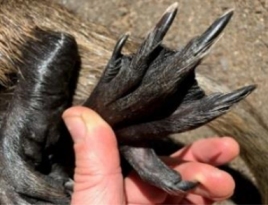
Nutria scat is typically 5 cm long and roughly larger than 1 cm in width. They vary in colour from brown, dark green, and near black. They contain discernible parallel grooves spanning their entire length, which can be used to distinguish them from beaver and muskrat scat. They are frequently found along the shoreline near feeding sites and floating in the water.
Nutria can be heard calling to each other, with their vocalizations often described as sounding like “mooing” or low pig-like grunts. Their calls serve to attract mates or signal feeding times.
The native range of Nutria spans across the Southern half of South America, through the countries of Brazil, Bolivia, Argentina, Chili, Paraguay, and Uruguay.

Nutria was originally imported to the United States in 1899 to be farmed for both its fur and meat. Many individuals were released into the environment both accidentally and intentionally after the demand for nutria plummeted in the 1940s (USDA, 2020). In certain states, nutria was introduced and sold as a means to remove and control unwanted aquatic vegetation. Today, it is found in at least 22 states across the U.S., primarily in the Gulf Coast. At present, Nutria populations have not yet established within Canada. The province of British Columbia, however, is considered at high-risk for invasion due to the proximity of established populations in the neighboring state of Washington to the south. Sightings have been reported in the lower Fraser River valley and on Salt Spring Island. It currently remains the only Canadian province with reported sightings.
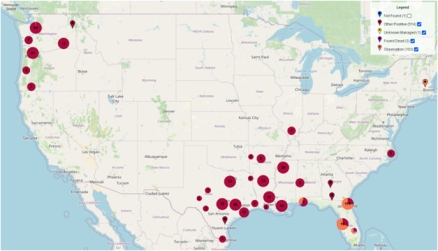
Ecological
Nutria have caused extensive environmental damage in wetland areas with high population densities. They are opportunistic herbivorous, feeding primarily on aquatic and semi-aquatic wetland vegetation. Nutria have been known to consume all vegetation from foraging areas, severely reducing the biodiversity of native plant species. A significant amount of the vegetation they feed on is essential for maintaining the structural integrity of wetland soil. The reduction of this vegetation contributes to the erosion and eventual loss of wetlands, which increases the vulnerability of nearby environments to erosion and flooding. Their burrowing behaviour further exacerbates erosion, weakening the bank stability of streams, lakes, and other waterbodies. Moreover, nutria have contributed to a notable decline in U.S. coastal marshes, and in some cases, extensive foraging and burrowing has resulted in the permanent loss of marsh vegetation and soil. These impacts also threaten sensitive populations of native wildlife that rely on wetland habitats.

Economic & Social Impacts
Nutria are capable of causing extensive damage to private and public infrastructure. Their burrowing behaviour weakens structures of bridges, culverts, and roadways, by means of erosion and settling. Their burrowing has proven especially problematic for the integrity of levees and irrigation canals used for water control and agriculture, causing cave-ins and flooding. Nutria burrowing also threatens flood-control levees that protect low-lying regions. Alterations in water supply to agricultural fields, alongside heavy grazing by the animal, have led to significant declines in crop yields, notably sugarcane and rice plants. They also damage economically significant crops, including corn, milo, beets, alfalfa, wheat, barley, oats, peanuts, and other vegetables, which poses a significant problem for farmers.
In Louisiana, nutria have been observed feeding intensively on bald cypress seedlings, the state tree, resulting in mortality.

Nutria serve as vectors for several pathogens that are harmful to humans, pets, and livestock including tuberculosis and septicemia. They are also hosts to a number of parasites including blood flukes, tapeworms, liver flukes, and a nematode that causes a skin irritation known as “nutria itch.” These organisms are transported through nutria urine and feces, which can enter and contaminate drinking water sources and swimming areas.
Management
In August 2023, the Government of Ontario proposed to include nutria in the list of prohibited species regulated under the Invasive Species Act.
Within the United States, comprehensive management plans are developed between local, state, and federal governments to protect natural resources from nutria damage.
Fences, walls, and other barriers can be erected to keep nutria from entering sensitive areas. To be effective, these barriers must be at least three feet in height and extend a minimum of 12 inches (30.5cm) underground since nutria are likely to dig.
Trapping nutria is currently the most effective method of removal from infested areas. Different trapping techniques are used such as the deployment of cage traps, foot-hold traps, rotating-jawed traps, colony traps, and the use of snares. Traps are baited using sweet potatoes, carrots, and other vegetables and fruit. More recently, the use of dogs trained on nutria scent have been employed allowing hunters and trappers to effectively catch the animal.
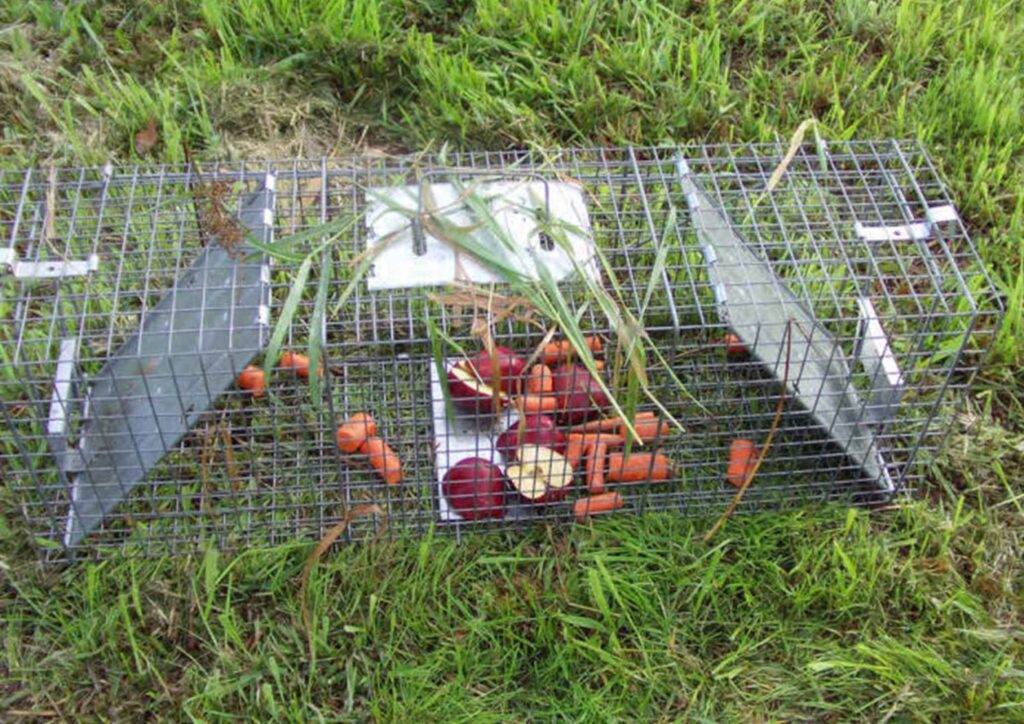
In the State of Louisiana, nutria pelts remain an important source of income for hunters and trappers. The value of nutria pelts incentivizes hunters and trappers, which in turn can assist in managing populations. Bounty systems have also been used to incentivize people to trap and kill nutria. Their meat is also consumed as a healthy alternative to traditional meat options.
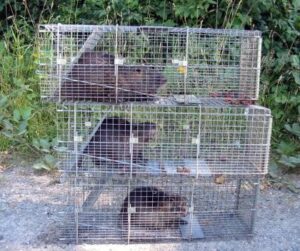
The use of zinc phosphide as a chemical control method has proven effective in eliminating nutria on a large scale. The poison is typically placed on bait-rafts and on carrots and sweet potatoes near burrows and dens; however, this method may lead to the unintended death of non-target species.
Other methods include releasing sterilized nutria fitted with tracking devices to further locate nutria populations. Relocation is not a viable option. Moving nutria to other locations will further their spread and potentially lead to greater damage.
Video: Using radio telemetry to track nutria movement. Source: United States Fish & Wildlife Service via YouTube.
References
Bertolino, S. (2022). Myocastor coypus (coypu). CABI Compendium. https://doi.org/10.1079/cabicompendium.73537
Chesapeake Bay Program. (2023). Nutria: Myocastor coypus. Chesapeake Bay Program.
Louisiana Department of Wildlife and Fisheries. (2023). The biology of nutria. Nutria.
The Editors of Encyclopedia Britannica. (2023, August 29). Nutria | rodent. Encyclopedia Britannica.
